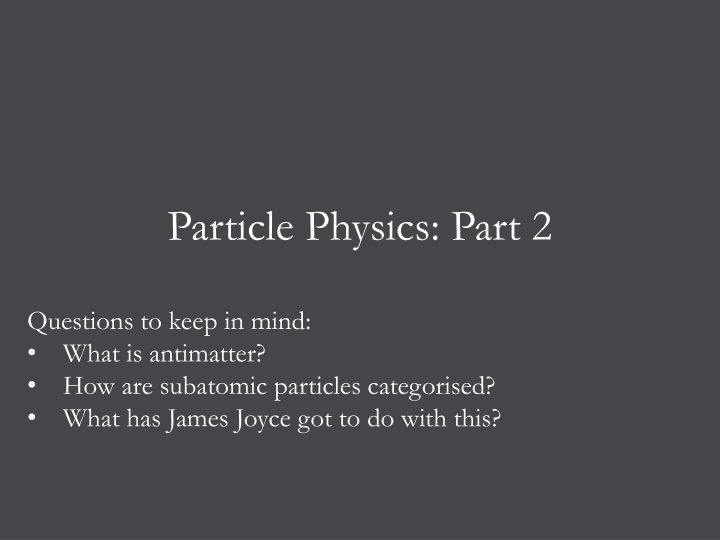
Unveiling Antimatter and Subatomic Particles in Particle Physics Part 2
Delve into the intriguing world of antimatter and subatomic particles as we explore how they are categorized within the realm of particle physics. Discover the fascinating discoveries made by scientists like Carl David Anderson and the mathematical predictions of Paul Dirac that led to the recognition of antimatter. Unravel the complexities of pair production, pair annihilation, and the classification of particles affected by different fundamental forces. Explore the Particle Zoo and learn about the various particles observed in accelerator experiments.
Uploaded on | 1 Views
Download Presentation

Please find below an Image/Link to download the presentation.
The content on the website is provided AS IS for your information and personal use only. It may not be sold, licensed, or shared on other websites without obtaining consent from the author. If you encounter any issues during the download, it is possible that the publisher has removed the file from their server.
You are allowed to download the files provided on this website for personal or commercial use, subject to the condition that they are used lawfully. All files are the property of their respective owners.
The content on the website is provided AS IS for your information and personal use only. It may not be sold, licensed, or shared on other websites without obtaining consent from the author.
E N D
Presentation Transcript
Particle Physics: Part 2 Questions to keep in mind: What is antimatter? How are subatomic particles categorised? What has James Joyce got to do with this?
What we already know Atoms contain protons & neutrons in the nucleus, surrounded by orbiting electrons. Charge is an inherent characteristic of particles. Particle accelerators accelerate and smash particles together. These collisions produce new particles out of the extra energy added (E=mc2) The four fundamental forces of nature are gravity, electromagnetism, strong nuclear force and weak nuclear force.
Antimatter is real In 1932, using a cloud chamber, Carl David Anderson spotted what appeared to be identically sized particles with opposite charges. He had detected a positron, a particle identical to the electron but with a positive charge. He knew it was positive as it moved the opposite direction to the electron when in a magnetic field (remember the left hand rule). A cloud chamber is a device that allows you to see tracks made by subatomic particles or ionising radiation. Click the link to see a clip of radiation passing through a cloud chamber. https://www.youtube.com/watch?v=i1 5ef618DP0
Antimatter is real Antimatter had been mathematically predicted by Paul Dirac in the 1920 s Anderson found that cosmic rays were creating pairs of particles. This is known as pair production. Pair Production The creation of two particles from energy. A particle and its anti-particle are created. Momentum and Electric Charge are conserved. It has been found experimentally that gamma rays can lead to pair-production when they collide with a nucleus. This is E=mc2in action, but with energy changing into mass.
Antimatter is real The energy of the gamma ray photon is converted into two moving particles that have kinetic energy. ? = ? = ?1?2+ 12?1?1 But m1= m2 12?2?2 2+ ?2?2+ 2 12?(?1 2+ ?2 2) ? = 2??2+
Antimatter is real The reverse process can also happen. Pair annihilation is when a particle and its antiparticle collide, causing the emission of two gamma ray photons e+ + e- 2hf Again momentum and electric charge are conserved. Name Symbol Charge e- Electron Positron Proton Antiproton Neutrino Antineutrino -1 +1 +1 -1 0 0 e+ or p p
The Particle Zoo From accelerator experiments physicists started discovering loads of new particles. They saw a pattern Some particles were affected by both the Strong & Weak Nuclear forces: Hadrons Some particles were affected by the weak force but not the strong force: Leptons
Hadrons Not fundamental particles, made of quarks. Feel all the forces. Two Types Baryons (made of three quarks) E.g. protons (p) and neutrons (n) and other heavier particles Mesons (made of two quarks) E.g. Pion (?+) and Kaon ( +) with masses between an electron and a proton All have antiparticles.
What the Quark? Imagined by Murray Gell-Mann, an American physicist. Named after a line from Joyce s Ulysses Three quarks for Muster Mark The Maths works. Six types of quark (each having an antiparticle) Charge and symbol of the following are on page 49 of the Tables book. Fractional charge relative to an electron. Name Up Down Top Bottom Charmed Strange Symbol u d t b c s Charge (e) +2/3 - 1/3 +2/3 -1/3 +2/3 -1/3
Back to Hadrons Example quark composition of Baryons Proton (uud) (2/3e + 2/3e 1/3e) = +1e charge Neutron (udd) (2/3e 1/3e 1/3e) = 0e charge You need to know these two. Example quark composition of Mesons Pion (ud ) (+2/3 +1/3) = +1e charge Kaon (us ) (+2/3 +1/3) = +1e charge
Leptons Do not feel the Strong Nuclear Force Not made of quarks Appear to be elementary particles (not made of anything else) Do not have a dimension, point objects. Will feel the gravitational force Will feel the electromagnetic force if they have charge. 12 known Leptons: Electron (e), muon ( ) and tau ( ) The antiparticles of these three ( e , , ) The associated neutrinos of these three ( e, , )and the antiparticles of these ( e, , ).
